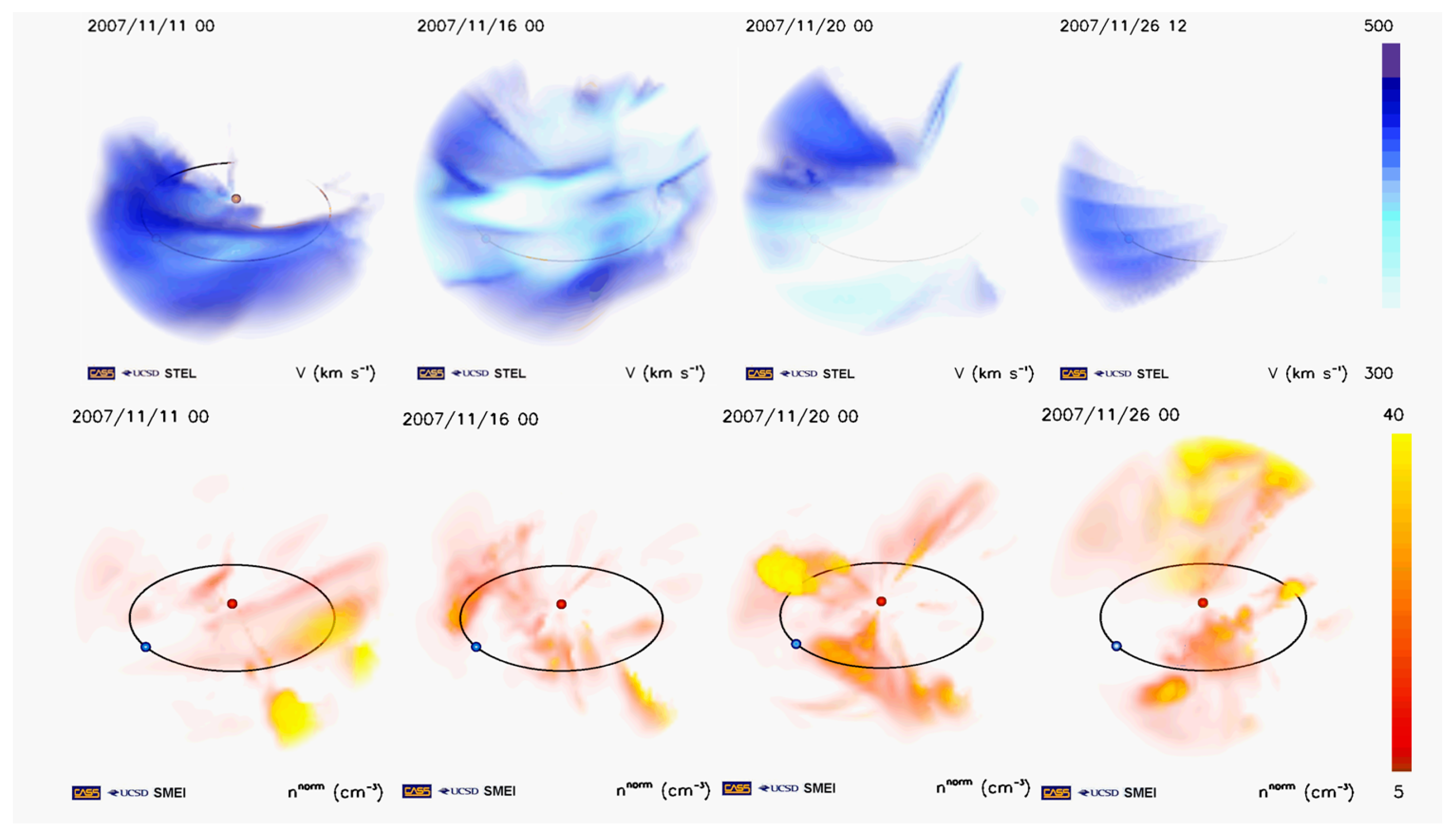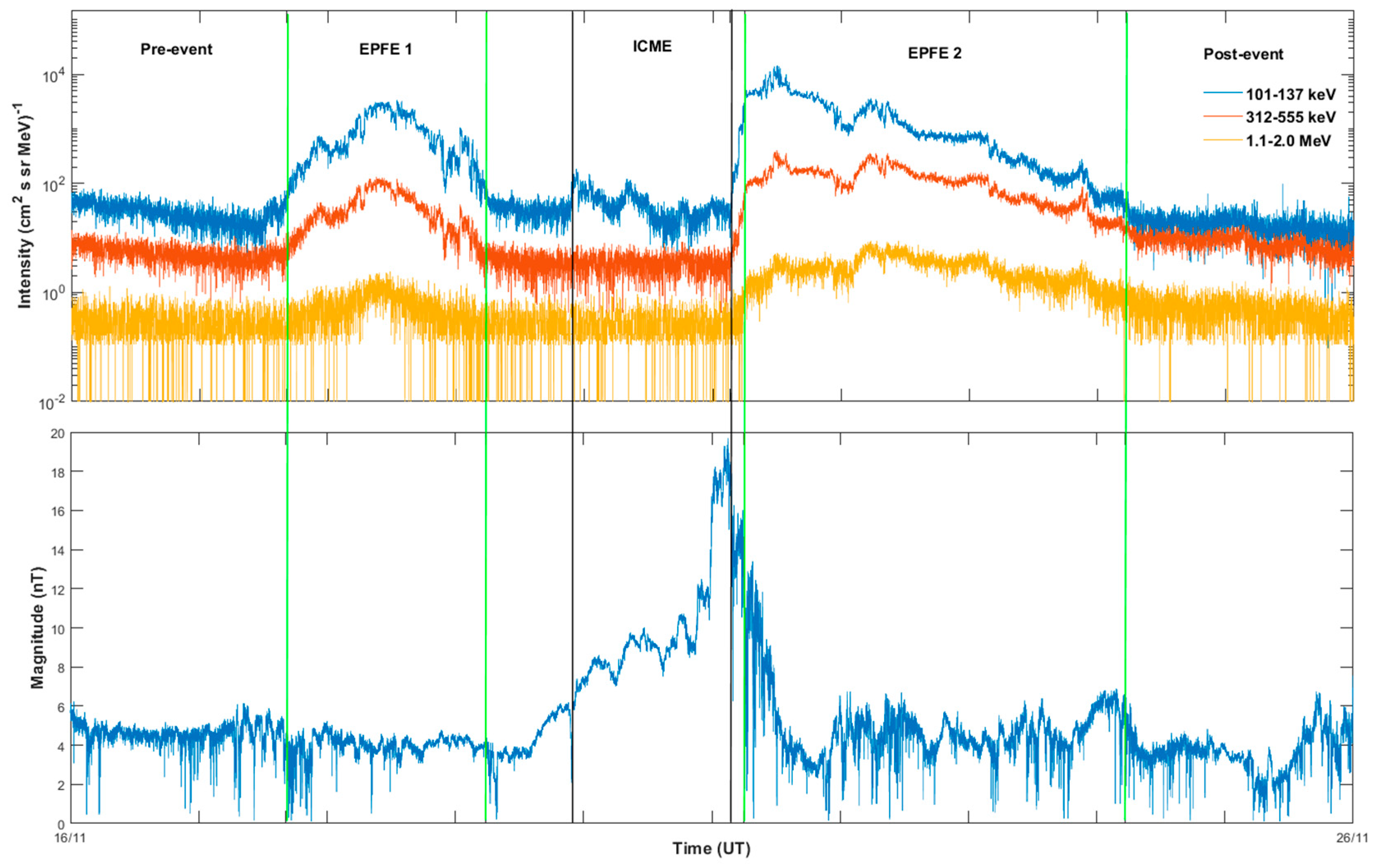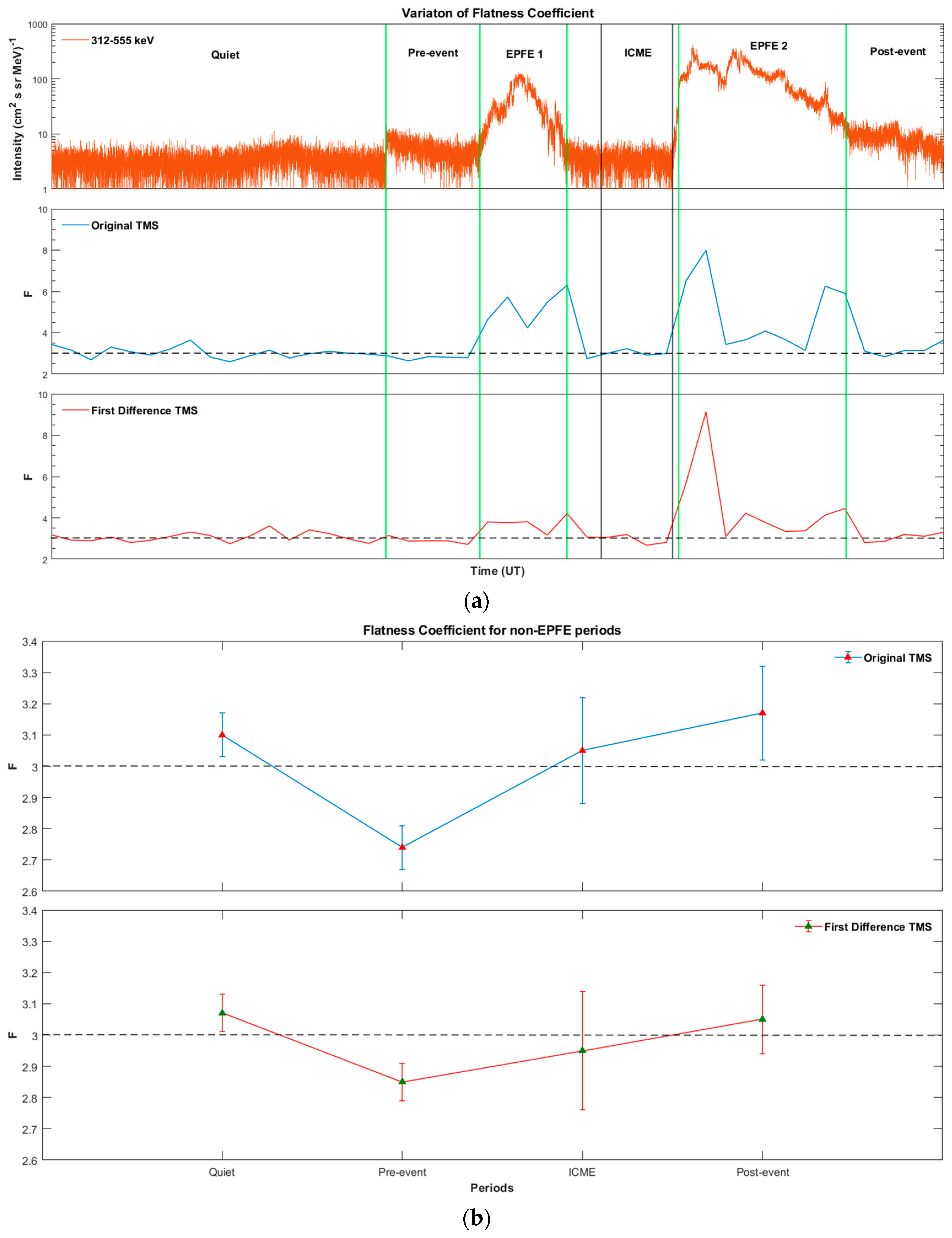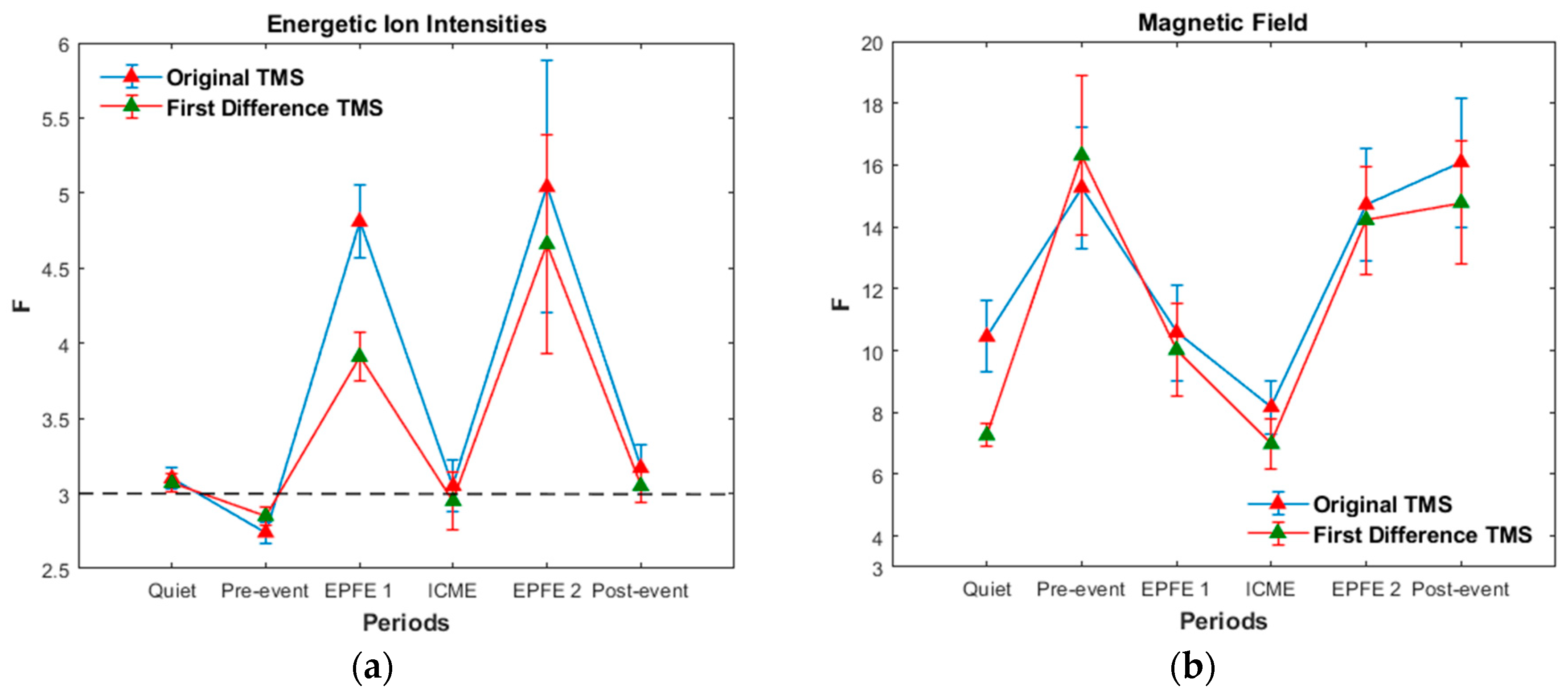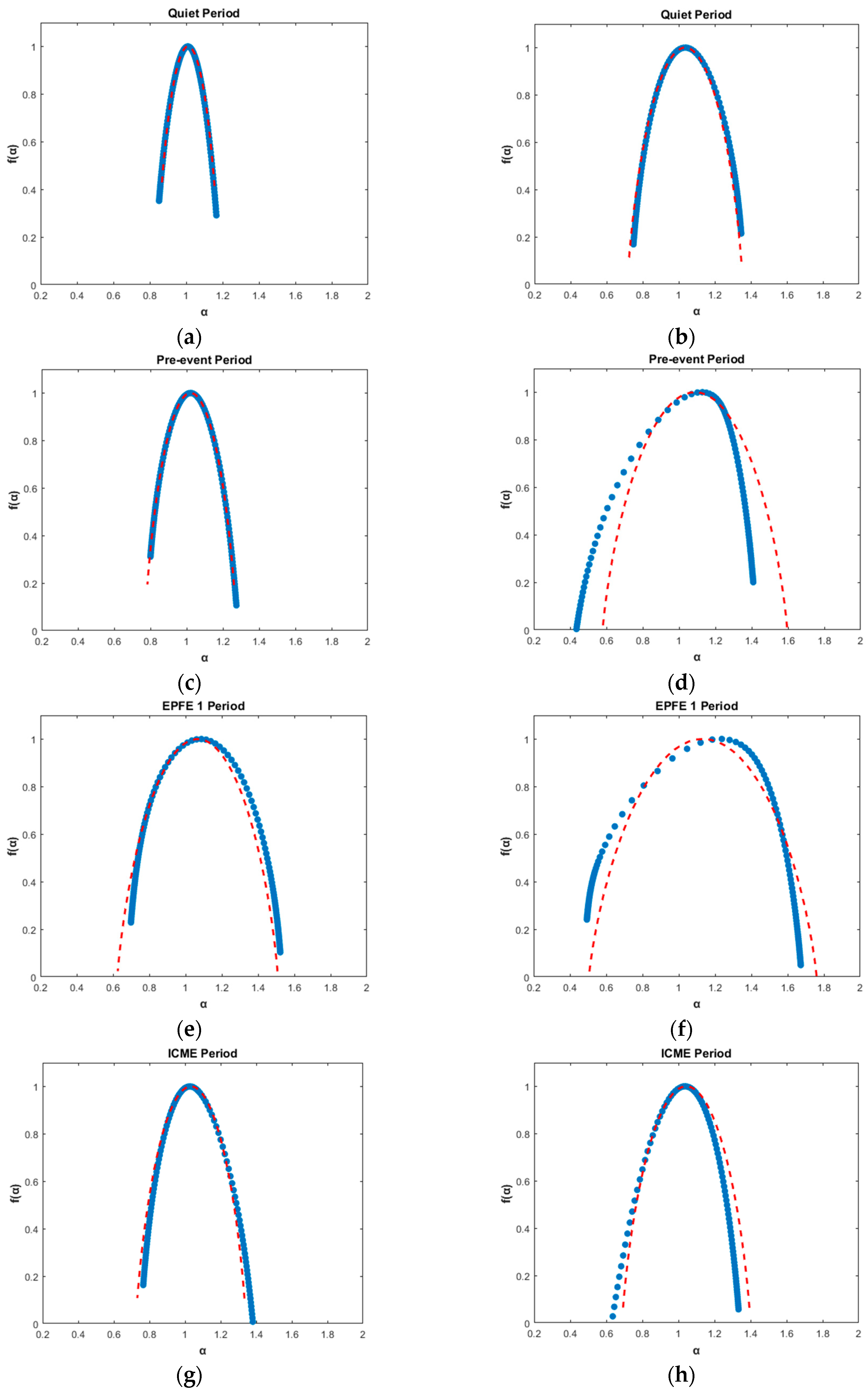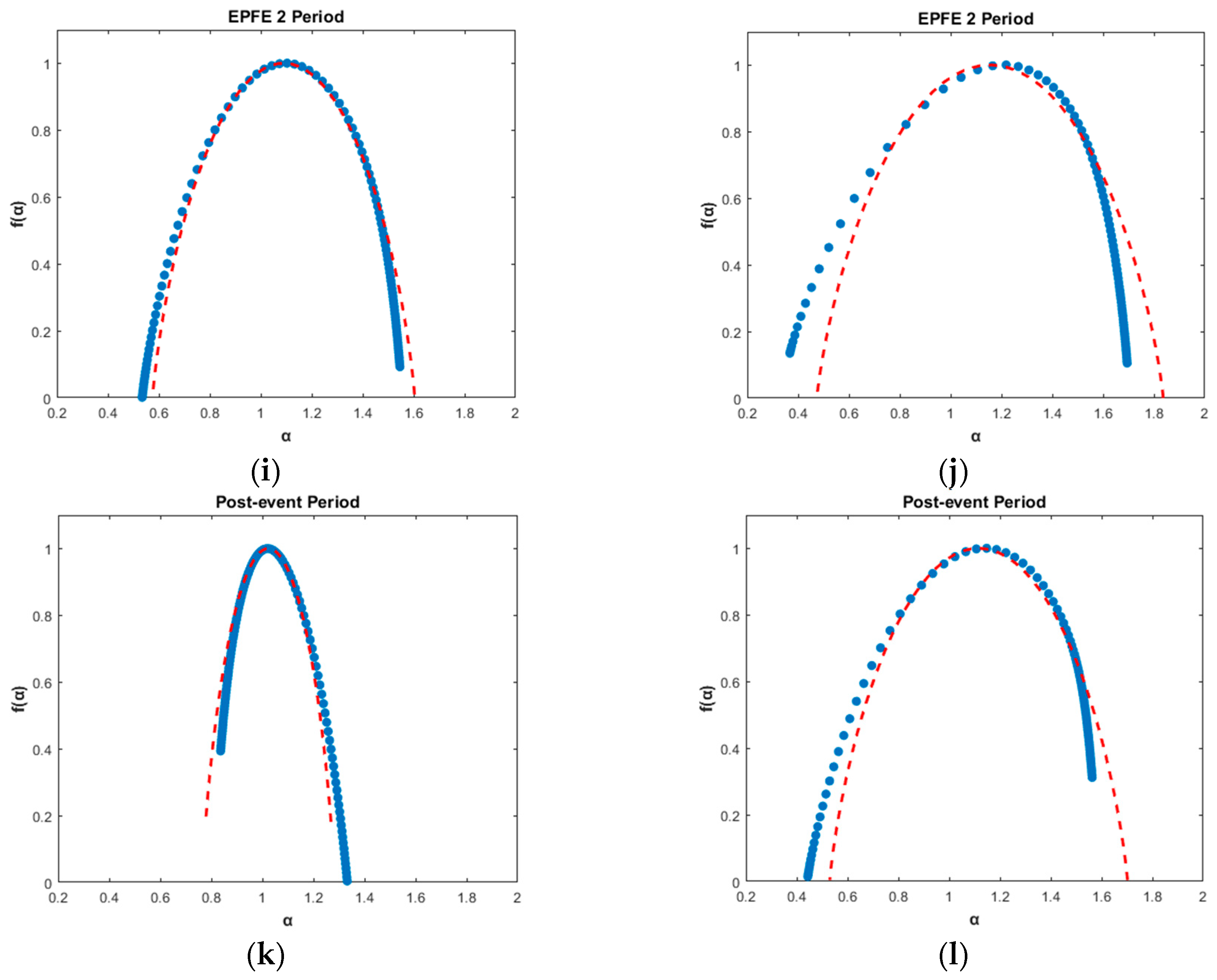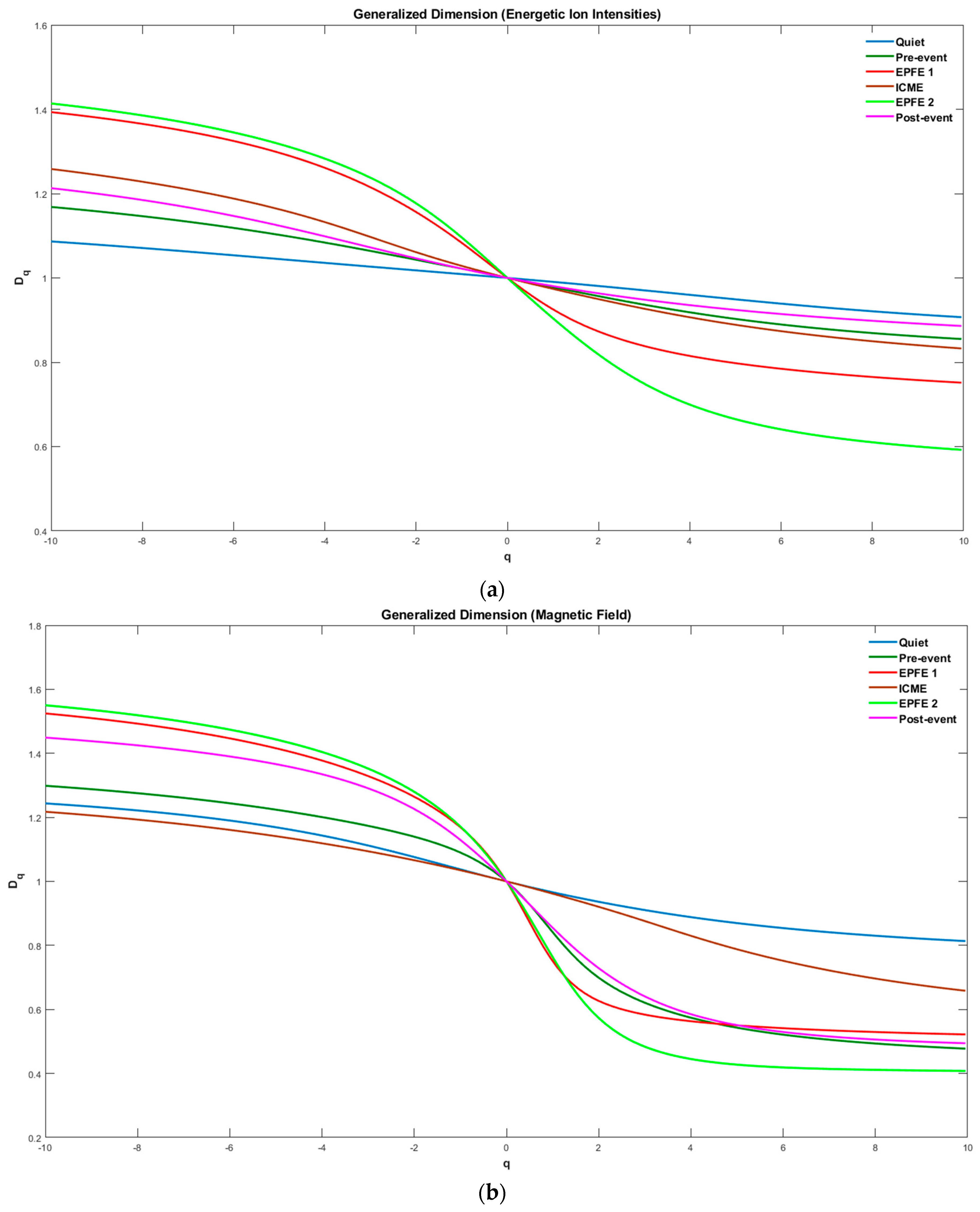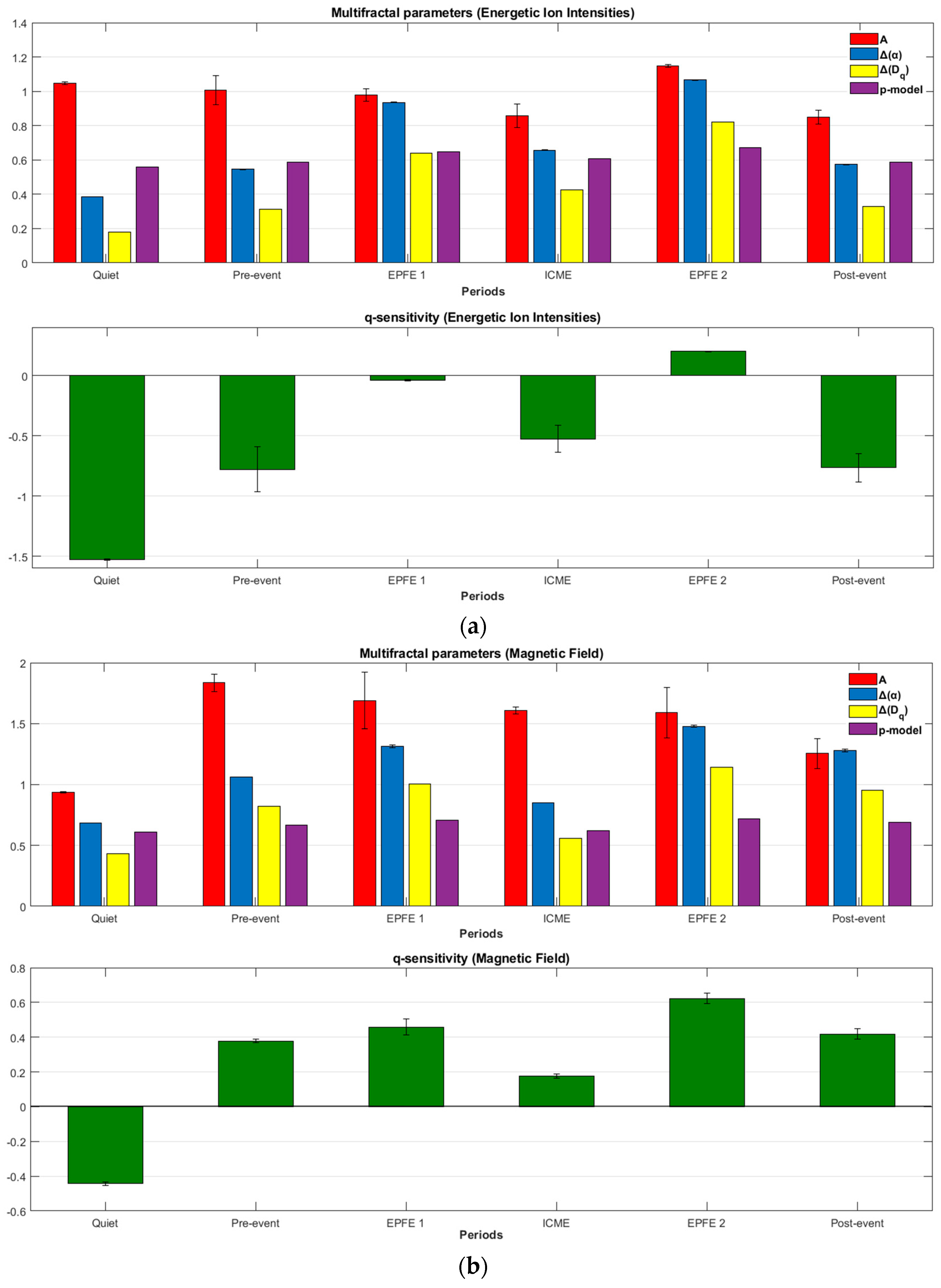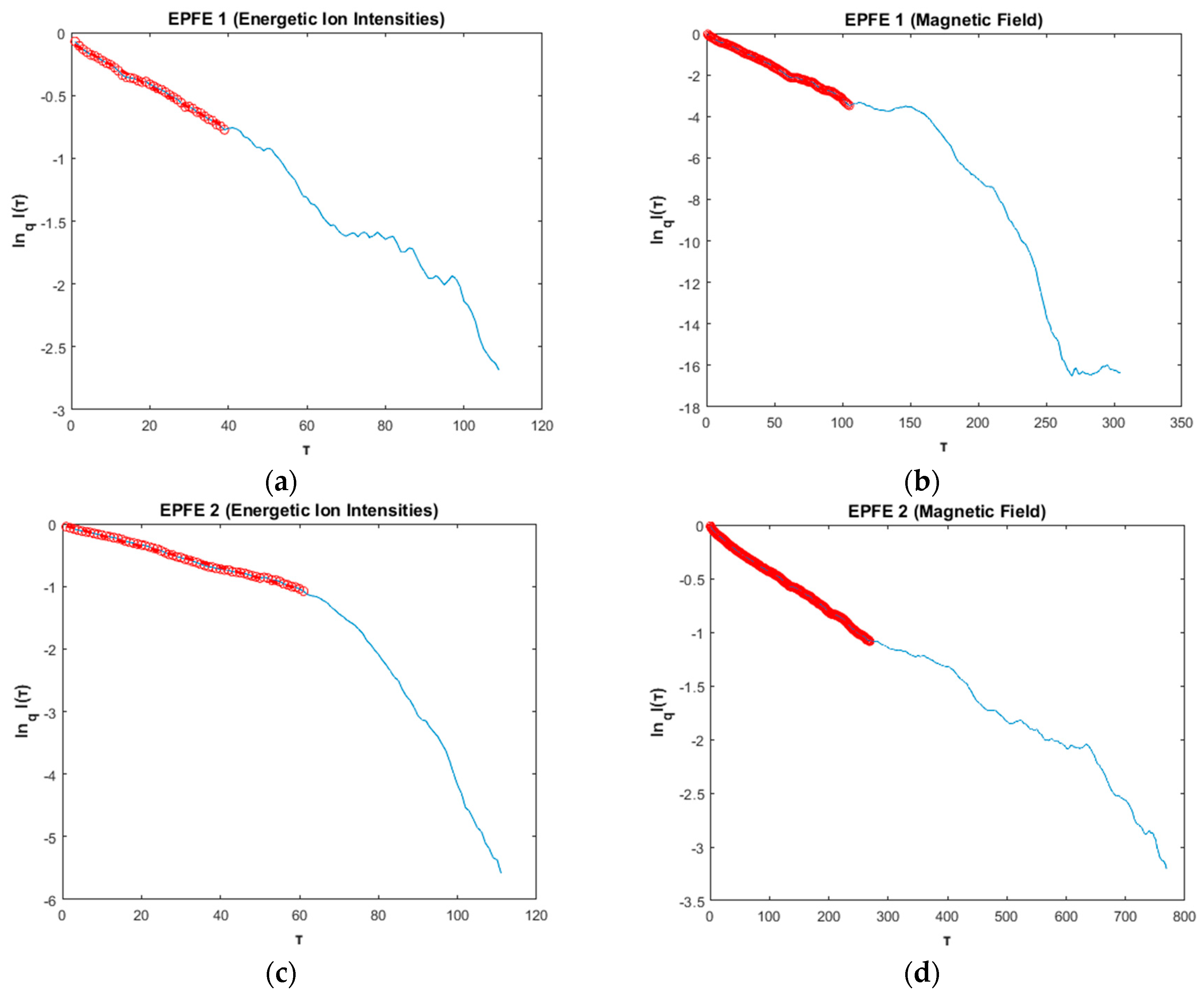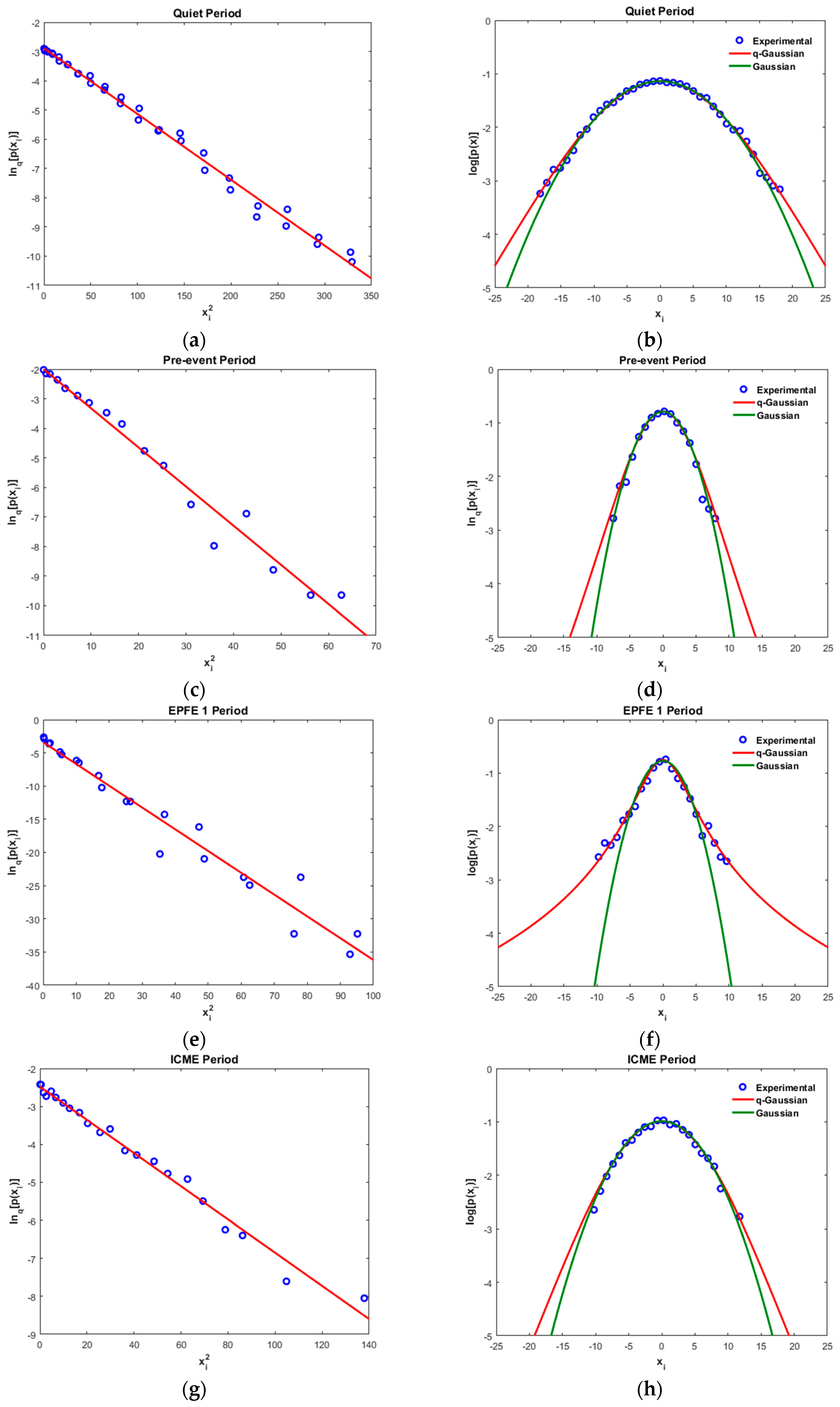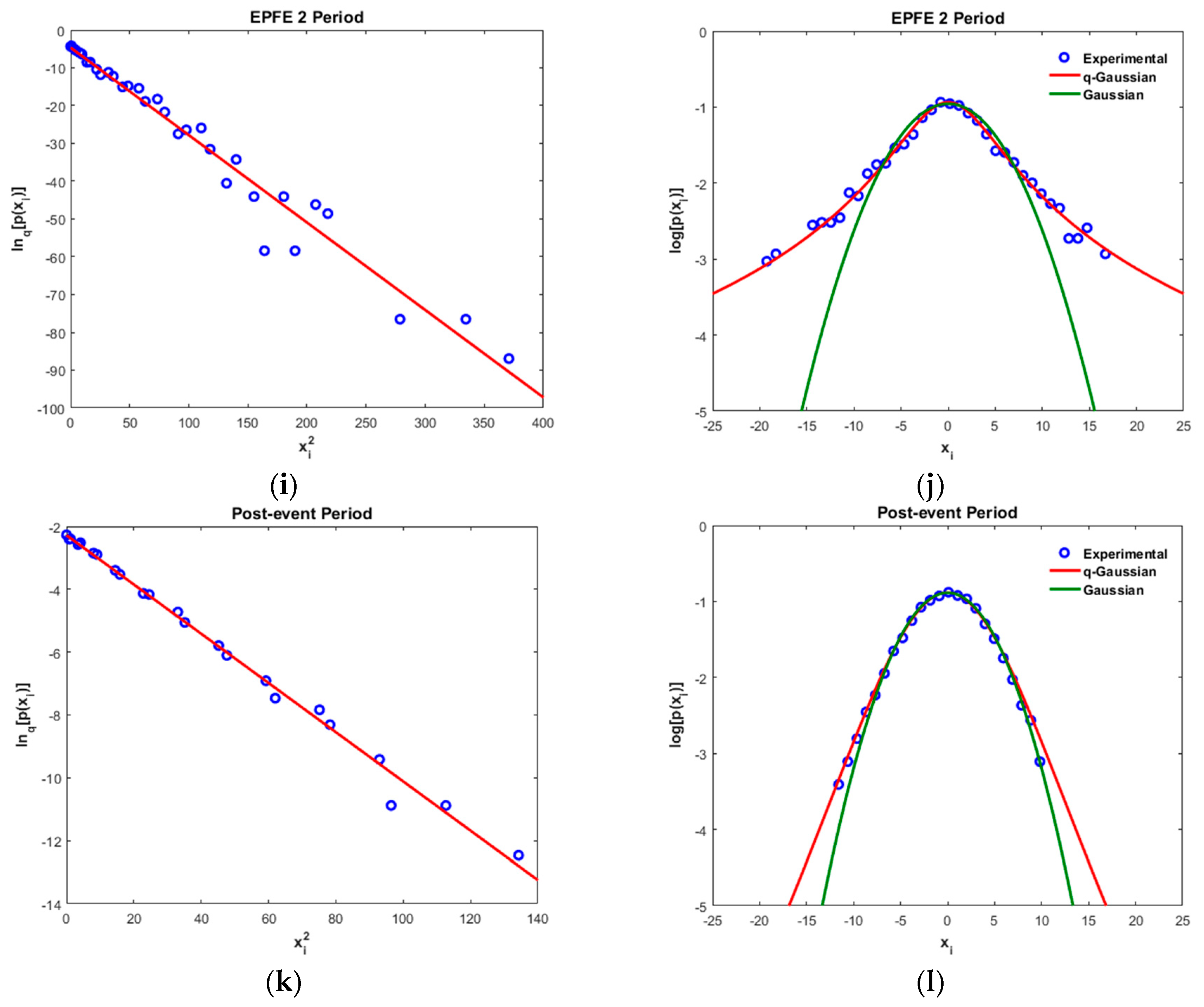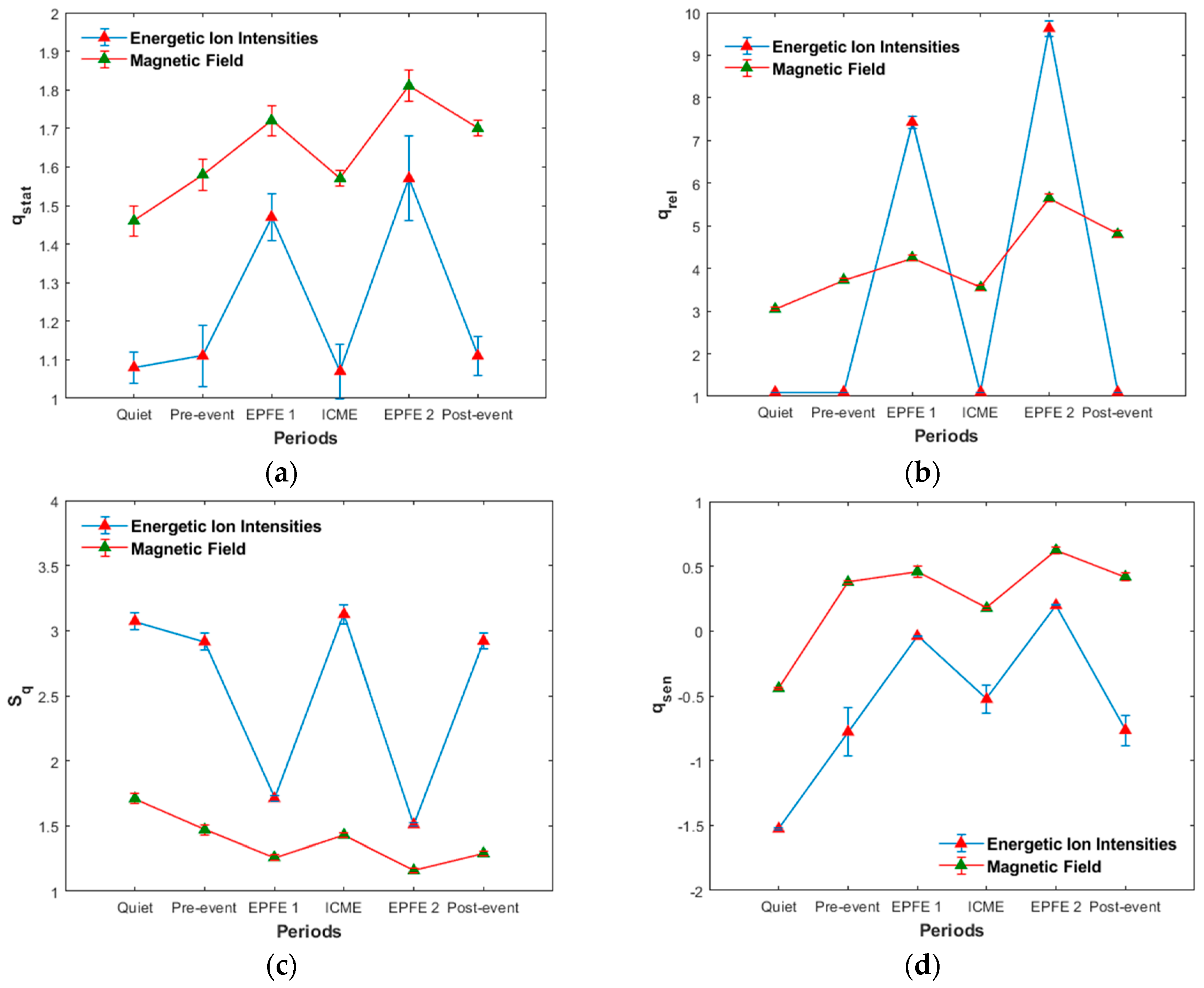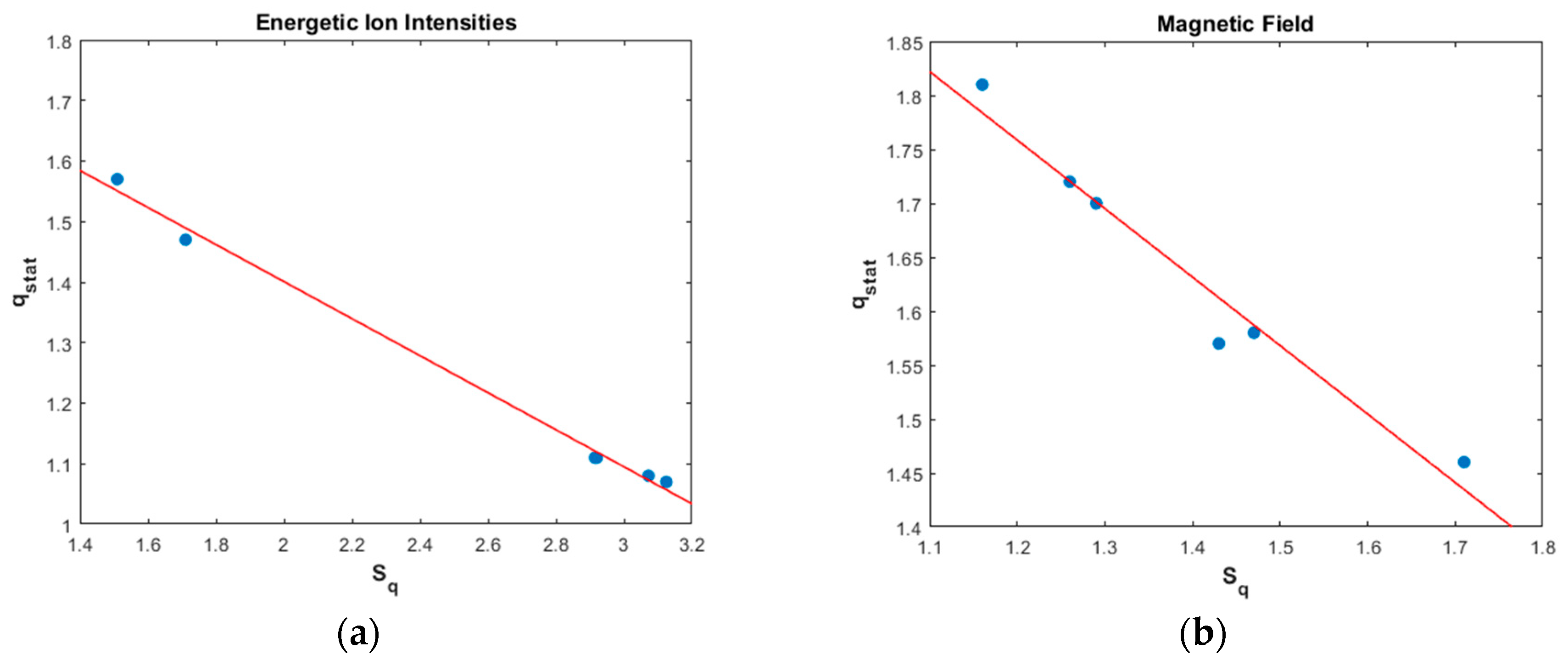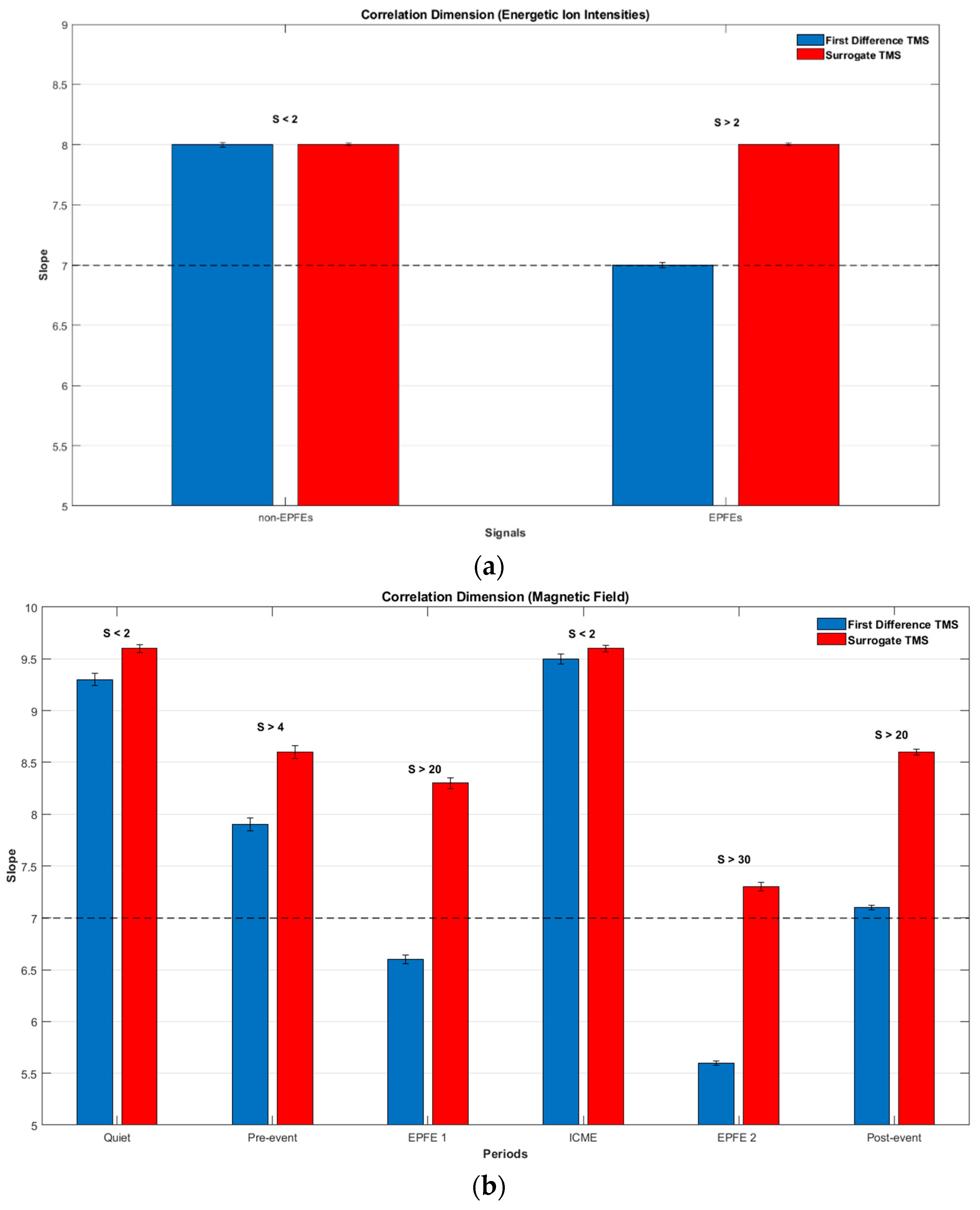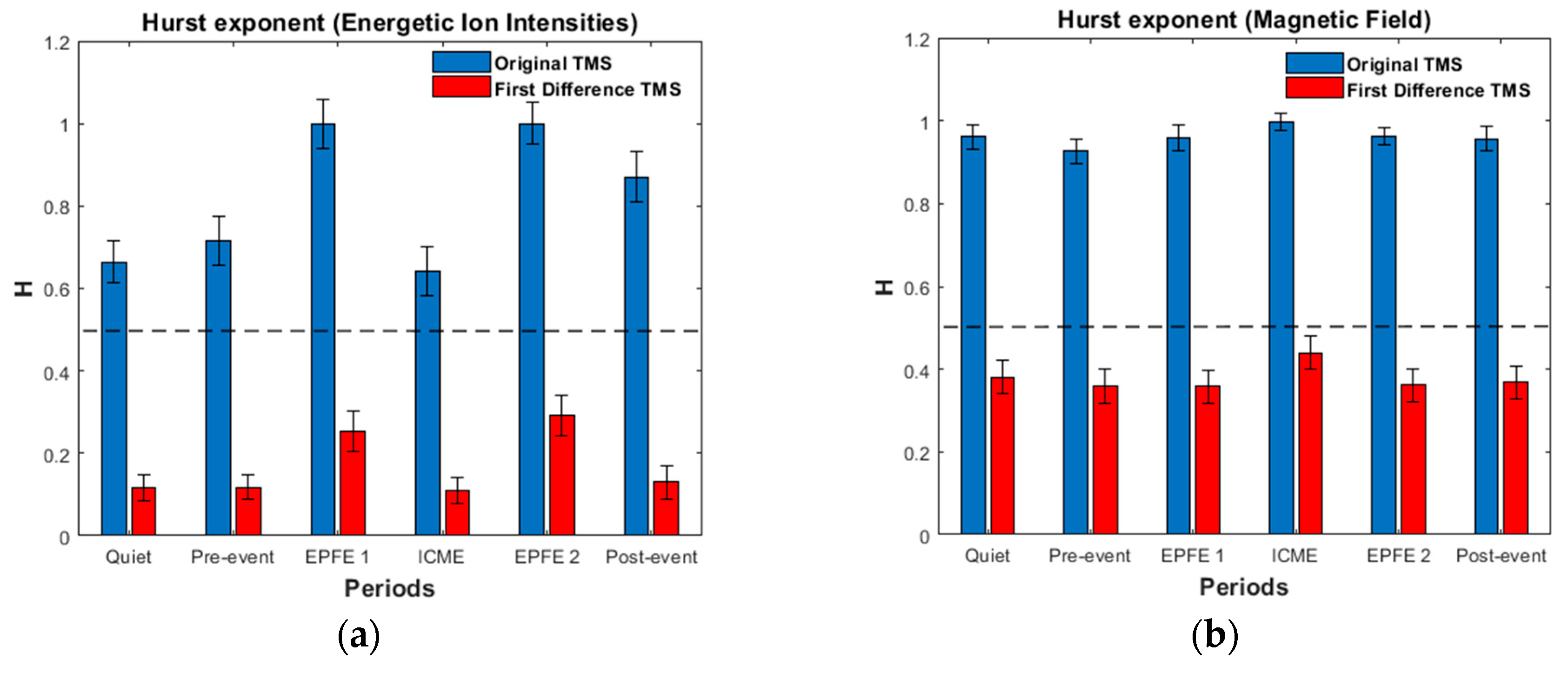The analysis has been carried out for TMS of the energetic ion intensities observed in the 312–555 keV energy range. Similar results (not shown) were obtained for the energetic ion intensities of 101–137 keV energies.
5.2. Tsallis q-Triplet Estimation
(a) Tsallis
Figure 6 shows the related singularity spectrum
as a function of singularity strength
for energetic ion intensity,
Figure 6 (left column), and magnetic field,
Figure 6 (right column), TMS, corresponding to six periods (quiet, pre-event, EPFE 1, ICME, EPFE 2, and post-event) as captured from the STEREO A spacecraft. The red dashed line is a nonlinear regression best fit of the experimental data making use of an analytical expression for tow-scale Cantor set with equal scales but unequal weights (p-model). As one can see in
Figure 6, the multifractal character changes as we pass from the quiet to the next periods and becomes stronger during the EPFE periods. However, there are significant differences between the multifractal curves which can be quantified using the Tsallis
index, as well as other geometrical characteristics of the singularity spectrums such as the value
, the degree of multifractality
, the degree of asymmetry
A, and the generalized dimension spectrum
[
77,
78].
First, we present results concerning parameters describing the geometrical properties of the curve of singularity spectrum
. Comparing the values of the four parameters obtained from the singularities spectrum, we observe the followings: The parameter
for EPFE 1 and EPFE 2 periods was found to be higher than the other periods (
Table 3). Similar results obtained for the magnetic field TMS (
Table 4). Therefore,
is smaller for the
spectrum of quiet, ICME, pre-event and post-event periods, in both cases of energetic ion intensity and magnetic field TMS. Smaller values of
indicate underlying processes with rather regular appearance (e.g., smoother TMS) since
is an indicator of the strength of the largest fluctuations [
79]. Therefore, our estimation of
for the analyzed event denotes that the energetic ion flux variations observed during the quiet, ICME, pre-event, and post-event periods are more regular (e.g., less erratic) than the corresponding ones occurring during the EPFE 1 and EPFE 2 periods.
Moreover, the estimation of the degree of multifractality showed that is greater during the EPFE 1 and EPFE 2 periods. Thus, higher values of indicate that the underlying process is richer in fractal terms, meaning that both the energetic particle ions and magnetic field exhibits more complex multifractal properties during the EPFE periods, than the corresponding quiet, ICME, pre-event, and post-event periods.
The degree of asymmetry A essentially gives information on the asymmetry of the singularity spectrum. When A = 1, is symmetric. For the energetic particle ions, the analysis reveals that the singularity spectrum of the pre-event period is the most symmetric since, for this period, the parameter was found to be . The results reflect the fact that the spectrum is almost non-skewed for the quiet, pre-event and EPFE 1 periods, left-skewed A > 1 for the EPFE 2 period, while for the ICME, and post-event periods it is right-skewed, since A < 1. Therefore, for the period during which A > 1 (EPFE 2) the spectrum is left-skewed, indicating a dominance of small fractal exponents related to an abundance of small fluctuations in the TMS, while for the periods during which A < 1 (ICME and post-event periods) the spectrum is right-skewed, indicating a dominance of large fractal exponents α related to an abundance of large fluctuations in the TMS. For the case when (quiet, pre-event, and EPFE 1 periods) the low and high fractal exponents , are of equal importance meaning an equilibrium of small and high fluctuations in the TMS.
Similarly, for the magnetic field the analysis reveals that the singularity spectrum of the quiet period is most symmetric since the parameter was found to be . In this case, as one can see, for all periods except the quiet period, the results reflect the fact that the spectrum is left-skewed (A > 1), indicating a dominance of small fractal exponents related to an abundance of small fluctuations in the TMS.
The results of the singularity spectrum presented in
Table 3 reveal significant differences between the singularity curves, indicating also differences between the corresponding processes that cause temporal variations of the energetic ion intensities. These obtained results are also verified by the estimation of Tsallis
index for the energetic particle ions, which revealed
. Similarly for the magnetic field, the obtained results for the singularity spectrum (
Table 4) are also verified by the estimation of the
index, which revealed
.
In
Table 3 and
Table 4, we summarize all the parameters
,
A,
,
, p-model, and
, with regard to the multifractal profile of the particle intensities and distributions, as well as of the magnetic field, as they were calculated in the SW plasma for all periods. The energetic multifractal profile of these periods described by the characteristic values of the multifractal parameters are included in
Table 3 and
Table 4. As one can see, all of the parameters during EPFE 1 and EPFE 2 periods simultaneously increase, for both the energetic ion intensity and magnetic field TMS. Moreover, we obtain that the parameters during period EPFE 2 are higher than the period EPFE 1, in both cases.
According to Sen [
79], in the case when
, this yields a power law behavior (instead of exponential, which indicates BG-statistics) for the sensitivity of initial conditions:
, where
is the distance of neighboring trajectories. Therefore, in both cases of energetic ion intensity and magnetic field TMS, according to the values of the Tsallis
and using the q-generalized Pesin-like identity (
with
), the processes related to the EPFE 1 and EPFE 2 periods are connected with a greater loss of information in phase space, as
, and greater rate of entropy production as
. Similarly, for the magnetic field TMS, the loss of information in phase space is:
, and the rate of entropy production is:
.
The singularity spectrum
is related to the generalized dimension spectrum
, as described above (see Equation (5)). The generalized spectrum
for positive values of
, describes low dimensional regions in the phase space, while the negative values of
describe high dimensional regions in the phase space.
Figure 7 shows, the generalized dimension spectrum
, for all periods during which the
spectrum was estimated. For periods 3 (EPFE 1) and 5 (EPFE 2), one can see a strong difference of
between the low
and high
dimensional regions of the phase space of space plasma dynamics, and the values of
. The generalized dimension for
corresponds to Correlation Dimension [
64]. As one can see, the generalized dimensions for
is lower in EPFE 2 period than the EPFE 1 period, for both energetic ion intensity (
Figure 7a) and magnetic field (
Figure 7b) TMS. In
Figure 7a, the value of
for EPFE 1 and EPFE 2 periods was found to be higher than 0.6. For the rest of the periods, the difference
remains smaller than 0.35, except for period 4 (ICME), during which
was found to be between 0.35 and 0.45. Moreover, it can be observed that the difference
is strengthened during period 5 (EPFE 2) (green curve) to the value 0.822 compared with the value of 0.641 estimated for the period 3 (EPFE 1) (red curve). The strong difference in the multifractal character seen during periods 3 (EPFE 1) and 5 (EPFE 2), which is reflected in the
and
values, is related with the physical mechanism of energetic particle production. According to the obtained results, the mechanism can be described as fractional acceleration process, as the multifractal character of phase space is strengthened. Moreover, the skewness is impacted by the temporal profiles observed during the EPFEs periods themselves.
Certainly, the topology of an event and the location of the spacecraft with respect to it may impact the characteristics of energetic particles and, consequently, the results of the statistical analysis. It is noteworthy that observations have shown that EPFEs (or AEPEs) observed in low-energy channels (up to 5 MeV) have a local origin. Such features as the detection of specific variations in the energetic ion flux along with propagation of the SW as detected by different spacecraft and the specific non-smooth profile of the energetic ion flux sitting on top of pre-existing SEP events and correlated with crossings of magnetic islands provide evidence in favour of that supposition. In this particular case, the restored IMF topology suggests formation of numerous magnetic cavities in HCS ripples. The ICME was very unusual in all senses and impacted by pre-existing streams. It is very unusual to see EPFEs well before and after the passage of an ICME. Especially the latter, taking into account that the solar source does not operate anymore, and there is no shock at the ICME trailing edge strong enough to produce an individual hump of the energetic particle flux peaking far from it. All together these points suggest that an additional mechanism of particle acceleration exists. Interplanetary Scintillation (IPS) and ENLIL (
http://helioweather.net/) reconstructions show that in similar cases the trailing edge of the ICME is highly skewed and forms a magnetic cavity confined more effectively than the pre-ICME one. As a result, magnetic reconnection producing magnetic islands occurs with an increased rate. Even visual inspection shows an increased number of drops in |B|, corresponding to crossings of current sheets separating magnetic islands, in the second EPFE period. One can suggest that the obtained statistical properties in regions EPFE1 and EPFE2 are mostly determined by the physical properties of the magnetic cavities containing magnetic islands, which, in turn, trap and re-accelerate energetic particles.
Furthermore, according to Zank et al. [
45,
46,
47], le Roux et al. [
48,
49,
50,
51], Adhikari et al. [
2], the effectiveness of the acceleration strongly depends on the characteristics of magnetic islands and magnetic cavities, confining them, which is different in EPFE1 and EPFE2 periods as already highlighted above. It is quite obvious that since the effect of local particle acceleration is stochastic and collective, the number of magnetic islands and the occurrence of larger-size magnetic islands change the efficiency of the acceleration considerably. In this term, the larger number of magnetic islands in the EPFE2 period can well explain the observations and this is what is meant by the impact of the topology on the characteristics of energetic particles and, consequently, the results of the statistical analysis.
It is noteworthy that the EPFEs were not observed only by single-point measurements. The unusual double enhancements were detected by STEREO-A and STEREO-B with a corresponding time shift, as it can be checked at
http://www2.physik.uni-kiel.de/stereo/browseplots/index.php. The separation angle between the two spacecraft was ~40 deg. L1 spacecraft also detected the event. The separation angle with the Earth is ~20 deg. Particle acceleration in magnetic islands occurs very quickly (see [
45]). Therefore, there is a strong reason to consider that we are dealing with spatial changes, observing a corresponding propagation of the magnetic cavities.
In
Figure 7b for the magnetic TMS, we observe similar results with energetic ion intensities (
Figure 7a). Once again, for EPFE 1 and EPFE 2 periods, one can see a strong difference of
between the low
and high
dimensional regions of the phase space of space plasma dynamics. The values of
were found to be larger than 1 for these periods, while for the rest of the periods, the difference
remains smaller than 1. It can be observed that the difference
is strengthened during EPFE 2 (green curve) than the EPFE 1 period (red curve).
During periods 3 (EPFE 1) and 5 (EPFE 2), the energetic particle intensities rise to values above
(see
Figure 2), in contrast with a quiet time background of the energetic particle intensities which is between
as seen in
Figure 3. At the same time, the multifractal profile of the energetic particle distribution is strengthened as the indices
,
and
show clearly enhanced profiles. This is strong evidence for fractional acceleration processes as the phase space of the system dynamics reveals a strong topological phase transition from a low to a high multifractal profile, since the multifractal parameters
,
and
reach much higher values than during quiet periods. Comparing the degree of asymmetry
A, between EPFE 1 and EPFE 2 periods, we observe that
A < 1 in the first period, while
A increases to value higher than 1 in the second one. This enhancement of the asymmetry index
A from period 3 (EPFE 1) to the period 5 (EPFE 2), is also associated with higher values of the energetic particle flux. Utilizing the observed intensities of the energetic particles, we calculated the total number of ions detected by the spacecraft during each EPFE period (i.e., the particle fluence). It was found that the EPFE 1 period comprised a particle fluence of
, while a much higher particle fluence of
was estimated during EPFE 2. The difference in the energetic particle fluence values is caused by the higher intensity values and the longer duration time of the EPFE 2 period, compared with the EPFE 1 period. We know that the asymmetry index
A depends upon the extension of low and high dimensional regions in phase space. As we have described previously (description of Equation (7)), when
A is larger than one the density of low dimensional regions described by the right part of the generalized dimension spectrum
, is higher than the density of high dimensional regions of the phase space described by the left values of
. Thus, in the case of
A > 1 corresponding to EPFE 2 period the mechanism of fractional acceleration process is strengthened, producing more energetic particle populations. This theoretical explanation of observations is in agreement with the profile of the generalized dimension spectrum shown in
Figure 7a, where the estimated low dimensional part of
spectrum
for the EPFE 2 period (green curve), is lower than the corresponding low dimensional part of
, estimated for the EPFE 1 period (red curve). We must note here, that the low dimensional regions of the phase space are associated with weak fluctuations and strong singularity of the topology of the phase space. This strong anomalous profile also produces strong anomalous diffusion and strong fractal acceleration processes. On the contrary, the high dimensional regions of phase space are related with large fluctuations and smoother topology of the phase space. As a result, the fractional acceleration process is weaker during the period 3 (EPFE 1), as it is concluded comparing the physical non-extensive states of the system at the energetic flux enhancements observed in period 3 (EPFE 1) and period 5 (EPFE 2), as shown in
Figure 7a. Also, the multifractality and intermittent turbulence profile of magnetic field indicated by parameters
,
,
, become stronger for EPFE periods and even stronger in EPFE 2 than in EPFE 1. The above results concerning energetic particles and magnetic field, showing the similar change of multifractality and intermittency, reveals the physical connection of the magnetic field underlying dynamics and the underlying dynamics of the energetic particles acceleration.
In
Figure 8, we visually illustrated the results from
Table 3 and
Table 4. As one can see in the upper panels of
Figure 8a,b, there is observed simultaneous increases of
(yellow bar),
(blue bar), and p-model (magenta bar) in the EPFE periods, for both energetic ion intensity (
Figure 8a) and magnetic field (
Figure 8b) TMS. Also, there is a strong enhancement of the
index (green bar) for the same periods. Moreover, the above parameters are higher in the EPFE 2 period than the period EPFE 1, for both TMS.
(b) Tsallis
In
Figure 9 we present the best
fitting of the mutual information function for the EPFE periods of energetic ion intensity (left column) and magnetic field (right column) TMS. With the red circles, we emphasize the linear fit used for the estimation of
index, according to Equation (12). For the energetic ion intensities, the results showed that the
index was found to be
for the EPFE 1 period (
Figure 9a), and for the EPFE 2 period the
index was found to be
(
Figure 9c). For the rest of the periods (quiet, pre-event, ICME, post-event), the estimated
values, are found to fluctuate near the value 1 as the relaxation time is very quick. After this, for the EPFE periods, the Tsallis parameter
remains different than unity and this reveals a non-Gaussian relaxation process of the system to its NESS, while for the rest of the periods the Tsallis parameter
remains close to unity and this reveals a near-Gaussian relaxation process of the system to its NESS. Similarly, for the magnetic field, the results showed that the
index was found to be
for the EPFE 1 period (
Figure 9b), whereas for the EPFE 2 period the
index was found to be
(
Figure 9d).
In addition, for the EPFE periods Tsallis q_rel index was found larger than the other periods, a result that indicates a slow relaxation process approach to NESS. The quiet, ICME, and pre/post event periods are characterized by very fast relaxation process. These results indicate strong self-organization of the SW plasma system during the EPFE periods and caused by some kind of topological phase transition process of the system dynamics. As we show in the following, the q_rel parameter increases as the non-extensivity and the multifractality of the system becomes stronger. In other words, as the q_sen and q_stat parameters are increasing, the q_rel parameter increases too. The slow relaxation of the system at the energetic flux enhancement periods (EPFE1 and EPFE2), is caused by the holistic behavior of the system as the self-organization (reduction of dimensionality) process is strengthened at the states with strong multifractality and non-extensive character.
(c) Tsallis
In
Figure 10 we present the results concerning Tsallis statistics for the energetic ion intensity TMS and for all periods. In particular, in the left column of
Figure 10 we present for all TMS, the best linear correlation (red line) between
(open blue circles) and
while in the right column of
Figure 10 we present the difference in long tails between the q-Gaussian (red line) and the Gaussian PDF (green line), in a
vs
graph. The open blue circles correspond to the experimental detrend TMS. In
Table 5 and
Table 6 presented the values that used to estimate the q-Gaussian distribution, for both energetic ion intensity and magnetic field TMS.
In all cases, the value Tsallis
suggests the presence of long-range interactions, a distinctive property of open non-equilibrium systems, with underlying dynamics characterized by non-Gaussian (q-Gaussian) distributions. It is the maximization of Tsallis entropy, which leads to the observed q-Gaussian distribution in contrast to BG formalism, which yields exponential equilibrium distributions. In addition, Tsallis
for the EPFE periods is much greater than the corresponding quiet, pre and post event, and ICME periods, indicating that in the EPFE periods the dynamics have a stronger sub-additive, non-extensive character, in both cases of energetic ion intensity and magnetic field TMS. Additionally, the κ index of kappa distribution is connected to the
index. Hence, through Equation (A14) the κ index for the six periods of energetic ion intensity and magnetic field TMS, was calculated to be
for quiet period,
for pre-and post-event periods,
for the ICME period,
for the EPFE 1 period, and
for the EPFE 2 period (
Table 5). Similarly, for the magnetic field TMS the κ index was found to be
for quiet period,
for pre-event period,
for the EPFE 1 period,
for the ICME period,
for the EPFE 2 period, and
for post-event period (
Table 6).
As we describe next, the kappa index describes the energy spectrum probability distribution. According to Equation (A14), as
increases the kappa index decreases while the probability distribution obtains higher values for higher energies. This means that the energy probability distribution obtains a stronger heavy tail profile as the non-extensivity and multifractality of the system is strengthened. This character of the energy probability distribution is described by Equation (19) in the discussion section. This is in agreement with our observations as the
and kappa indices correspond to higher probability values at the same energies when they are compared between those periods. For higher values of
the density of particles of energy E is higher. This can be explained through the kappa distribution of energies, which are caused by optimization of the Tsallis q-entropy [
80,
81,
82].
(d) Evolution of q-triplet
In
Table 5 and
Table 6, and
Figure 11, we present the evolution of non-extensive statistics from period one to period six, for both energetic ion intensity and magnetic field TMS.
Concerning the energetic ion intensity measurements, the
values for periods quiet, pre-event, ICME, and post-event, remain near the value 1 but are clearly different than the Gaussian value of
. As concerns the magnetic field measurements, the
parameter for all periods is clearly different, much higher than the value 1. From period 1 to period 6, we can see a general tendency for increase of the
index. The maximum values of
was found for EPFE periods, with higher value for EPFE 2 period (
Figure 11a). The indices
and
follows the variation of
index for both kind of measurements (
Figure 11b). For the energetic ion intensity measurements, the value of
index for periods quiet, pre-event, ICME, and post-event it was not possible to be calculated exactly as the relaxation process happens very quickly. For this reason, we estimate that the values of
index are higher than the Gaussian value of 1 but near at this value, taking into consideration the
index, Flatness coefficient, and p-model parameter. As concern the values of entropy
and the rate of entropy production
, we observe similar behavior between energetic ion intensity and magnetic field measurements (
Figure 11c). However, comparing the
and
values with
index, we observe the opposite behavior. Lower values observed during EPFE periods for both kind of measurements, and are even lower in the EPFE 2 compared to the EPFE 1 period. This profile of evolution of entropy, indicates the existence of distinct NESS of the SW plasma. All these results presented in
Table 5 and
Table 6, and
Figure 11, clearly indicate a phase transition process between distinct NESS of the SW plasma during the SMIs events.
In
Figure 12, we present the linear correlation between q-entropy
and
for energetic ion intensities (
Figure 12a) and for the magnetic field (
Figure 12b). As we can see, there is a negative correlation between
and
, for energetic ion intensity TMS for magnetic field TMS. The value of
corresponds to the NESS. As shown in
Figure 12, the q-entropy maximum clearly decreases for EPFE periods, and suggests that the NESS becomes more organized, which means that fewer effective degrees of freedom are available to the dynamics as the entropy decreases. This is in accordance with the basic theoretical framework of Tsallis theory and our previous results concerning the
parameter, which was found to increase in EPFE periods: As
increases, the long-range correlations become stronger causing the decrease of the entropy.
